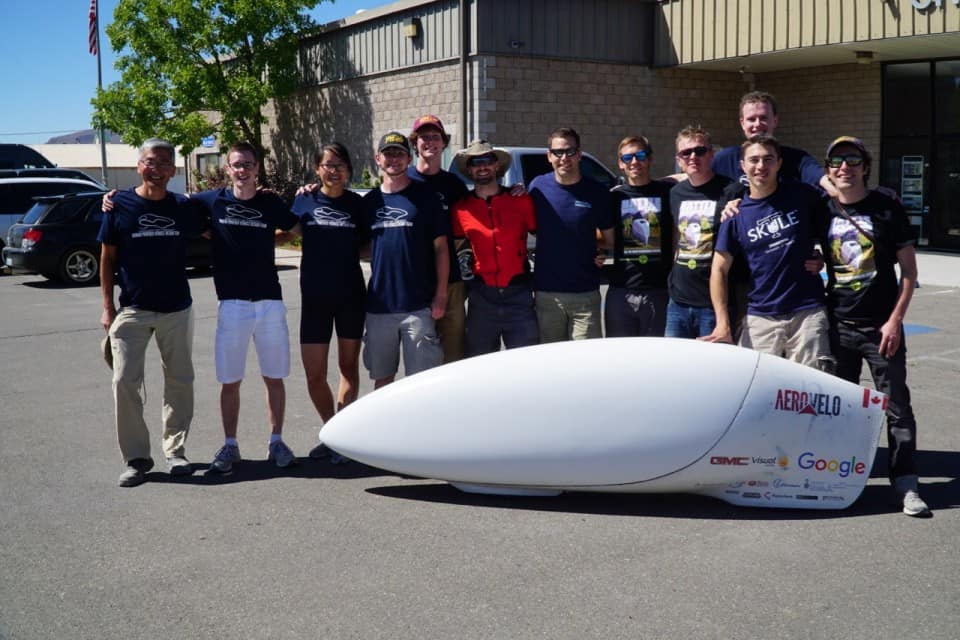Battle Mountain, Nevada, a community of no more than 5,000 residents, holds an eight km stretch of what is possibly the smoothest road surface on Earth. Except for a shallow scar about halfway down the road resulting from a recent truck accident, the road is free of any seams or holes. It was this segment of state route 305 that allowed Todd Reichert to roll at a speed of 139.45 km/h during the annual World Speed Challenge on September 17, breaking the world record for the fastest bike.
The true star, ‘Eta,’ is a speedbike designed corroboratively between the Human Powered Vehicle Design Team, or HPVDT, established by graduate students at U of T’s Institute of Aerospace Studies in 2006, and AeroVelo — a company that similarly designs and hopes to commercialize human-operated vehicles.
AeroVelo was established in 2012 when two HPVDT alumni, Todd Reichert and Cameron Robertson, formed the original team. HPVDT members who participated in the project include Trefor Evans, Alex Selwa, Thomas Ulph (Engineering Science, Aerospace), Marc Jutras, Calvin Moes (Materials Science and Engineering), and Peter Wen (Mechanical and Industrial Engineering).
AeroVelo started on Eta early in 2014 with irreplaceable contributions from HPVDT, whose data and trials pertaining to the mechanics, the aerodynamics, and the ergonomics of previous models were integral to the design of the bike.
Moes, who is captain of the HPVDT, described the World Speed Challenge as “very organic… the whole point is to see how fast we can go, and any competitiveness is all in good fun.” While Moes reported seeing a few locals coming out to watch, the competition mostly involved the competitors out on a desolate highway riding the most absurd looking bikes imaginable.
What distinguishes a speedbike from its more humble domestic counterpart is its highly aerodynamic shell, or to use the technical term, its ‘fairing.’
“Even in an all-out sprint, the best cyclist on a regular bicycle will top-out at around 75 km/h because there’s so much work being done to push the air out of the way,” Moes explained. “Mechanical efficiency also makes a big difference; we’ve got excellent tires and efficient chainlines.”
A major challenge in speedbike design, comically, lies in fitting the rider into the bike, or more accurately, building the bike around the rider while allowing enough space for them to pedal properly. An even more absurd factor in the design is that in order to preserve aerodynamics, the speedbike riders have to depend on a camera to see outside of their vessel, since using transparent material can result in glare.
“Once you get past the initial strangeness of riding a bike by camera, it’s actually better than a window, since you can have auto-contrast adjustment, plus all your performance data on the screen,” Moes said. “Aside from turning off the guidance computer and using ‘The Force’, I don’t think we’re going to find anything better.”
While engaging in strenuous exercise, confined in a shoulder wide vessel, the riders also have to bear a very noisy ride that Moes described as “too loud to be able to think.” “What most people don’t realize about modern cars is the amount of effort that goes into damping out road and engine noise,” Moes added. “Without all that added weight and complexity, everything would vibrate and resonate… Speedbikes don’t have much that damps out vibrations, and carbon-fibre is notoriously stiff, so that large and flat carbon-fibre surfaces — like the fairing, frame, and wheelwells — amplify the sound of road vibrations.”
If being a vehicle engineer and breaking world records is not enough to mention on your dating profile, most of the HPVDT members are all accomplished cyclists. This extensive experience is called for due to the bike’s design. “Recumbent bikes are more sensitive to balance and steering than upright bikes, and this gets worse the closer the rider is to the ground. Speedbikes like Eta are as short as possible, so they’re quite touchy to handle,” Moes said.
HPVDT is currently working on a new speed-slash-utility bike that will be as fast as a car and able to handle real-life road conditions, unlike the speedbike, With the multitude of global issues ranging from energy crises and the rise of sedentary citizens, to the less concerning parking crises, we will soon be forced to resort to different forms of personal transportation.
Even though the HPVDT was not an official contender in this year’s competition, the team will be entering their current project “Eta Prime” to next year’s tournament, with Calvin Moes being the ‘designated driver’ — so keep a lookout for Moes and Eta Prime in upcoming world records.


